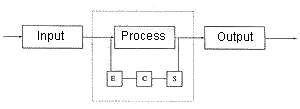| (a) | What is the formula for the payback period, before the introduction of taxes? | [1] |
| P = I / R where
|
||
| (b) | Give one example of each of the following types of interview questions: | |
| (i) Open-ended questions. | [1] | |
| (ii) Closed questions. | [1] | |
| (i) What do you think
of about microcomputers for managers? (ii) How many subordinates do you have?
|
||
| (c) | What is a Gantt chart? | [2] |
| Gantt chart is a bar
chart that shows all the activities carried out in a system project and the time schedule
of each of those activities.
|
||
| (d) | List three disadvantages of the structured analysis and design methodology. | [3] |
|
||
| (e) | Given the basic system model shown below,
identify one area in which an improvement to this model can be made, and also state
one application area in which it could be used.
|
[3] |
| The model can be
improved by including a predictor. An example of an application area is the stockmarket
system whereby the system is able to predict the trend of the market.
|
||
| (f) | Describe two situations in which you might use a decision tree. | [2] |
|
||
| (g) | What is the purpose of a structured walkthrough? | [1] |
| Strutured walkthrough
is a formal meeting organised to review the system development processes with the aim of
improving quality.
|
||
| (h) | Describe two potential sources for conflict which should be kept in mind when determining and evaluating system constraints. | [4] |
|
||
| (i) | Name two categories of computer-based information systems. | [2] |
|
